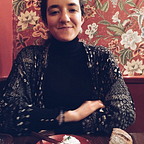In “The Margot Affair,” Sanaë Lemoine Examines The Complexities & Failings Of Family Against The Backdrop Of French Food
Sanae Lemoine’s debut novel, The Margot Affair, tells the story of Margot Louve, the 17-year-old daughter of a prominent, ambitious French politician and an actress with whom he’s carried on a long-time affair. Set in the Left Bank of Paris, the narrative considers multiple dualities: public appearance against private life; the danger of truth against the cost of secrecy; and the cruelty of deceit against the desire to be seen and heard.
Reminiscent of the real-life political scandal involving the former President of France, Francois Mitterand, who had a daughter with his mistress, Anne Pingeot, The Margot Affair is a deeply compelling and exceptionally subtle examination of the complexity and failings of family.
The plot, while grounded in Margot’s journey to expose the truth of her father’s identity, is teeming with portraits exploring the nuances of motherhood as it relates to love and loss, tension and understanding.
As a former recipe writer and editor, Lemoine masterfully peppers the story with vivid descriptions of food as a proxy with which to talk about the comforts of family and hunger for acknowledgment. Below are select snippets that stood out to me — written with an effortless ease that mirrors the style of the less-is-more cooking itself.
“For dinner Mathilde made a tomato tart with fennel salad. She had bought the tomatoes at the market and they spilled juice onto the cutting board as she sliced them open. She always made her own crust and shaped it like a true pâtissier, leveling off the edges until it was flush against the mold. Beneath the tomatoes, she added a layer of parsley pesto and grated cheese. I helped her pick fennel fronds for the salad.”
“Mathilde prepared lunch, a salad with radishes and slices of cheese. She bought a fresh baguette and tidied the kitchen, setting the dishwasher to run and cleaning the stove.”
“The clafoutis sat on the table, the plate hot from the oven. Caramelized slices of pear hid beneath the custard, and the top was sprinkled with shards of toasted almonds. She scooped a portion into a bowl and placed it in front of me. Steam clouded the underside of my spoon.”
“We often ate snacks in the kitchen. Tea or coffee if it was earlier in the day. Slices of cheese with toasted bread. Almonds and dried apricots. Sometimes I picked up a pastry on my way over. Brigitte cut it into small pieces and served it with homemade pear or plum jam. But I always left before dinner, not wanting to intrude. Back home, I often ate alone, soup in a carton or a can or sardines or mackerel. I forced myself to eat the entire can, chewing on the small bones and sopping up the oil with bread. It made me nauseous, but I didn’t want to throw it away, knowing it would stink up the kitchen.”
“I sat at the table watching her boil water for spaghetti. She sliced the onion thinly and made a sauce with caramelized onions and bacon pieces. She opened a bottle of white wine and added a splash to the pan. It evaporated almost immediately. As the pasta cooked, she made a salad with radishes and herbs…Brigitte tossed the spaghetti in the sauce and added a few tablespoons of cream…I ate slowly, taking my time to twirl the spaghetti around my fork. For dessert, she served pieces of dark chocolate and opened a bottle of red wine.”
“One afternoon she showed me how to make soft-boiled eggs. She filled a saucepan with water and placed it on the stove. In the winter she kept eggs by the windowsill. She plucked two from the carton and slipped them into the roiling water one by one, her fingers almost touching the water. She turned the heat down to a gentle simmer and stirred them for thirty seconds. We waited six minutes. It was an act she did mindlessly. She had made eggs hundreds of times, whereas I only knew how to scramble or fry them. As we waited for the eggs to finish cooking, she drizzled slices of bread with olive oil. We ate the eggs with sea salt and a splash of red wine vinegar.”
“We bought a roast chicken with potatoes from the butcher across the street, and they came with bottles of wine, walnut bread, and a beautiful assortment of cheeses: a large block of aged Comté, a ripe Epoisses, an ash-dusted chèvre, and a pungent blue. Anouk unwrapped a block of salted butter. The top was imprinted with a cow and the salt crystals glittered on its surface. I set the cheeses out for later, so the Epoisse’s creamy center had time to trickle out onto the board, its flavor blooming at room temperature. Théo assembled a festive salad with dried fruit, hazelnuts, radishes, beets, and large leaves of lettuce that we tore in half before adding to the bowl. We toasted chestnuts on the gas stove as an appetizer. For dessert, Mathilde prepared bowls of her own cherries soaked in eau-de-vie.”
“Brigitte had prepared stewed mussels and a green salad with pickled fennel. The shells swum in a garlic and white wine sauce with bits of bacon. I hadn’t tasted the sea in a long time. It reminded me of the restaurant in Normandy, the chef who was Father’s friend.”
